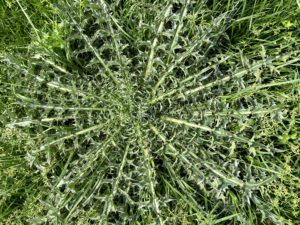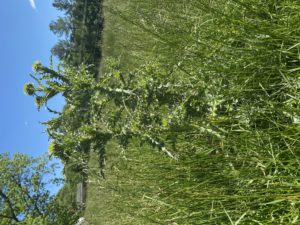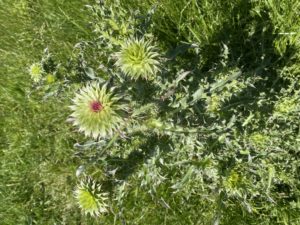Thistle – Weed ID
go.ncsu.edu/readext?688359
en Español / em Português
El inglés es el idioma de control de esta página. En la medida en que haya algún conflicto entre la traducción al inglés y la traducción, el inglés prevalece.
Al hacer clic en el enlace de traducción se activa un servicio de traducción gratuito para convertir la página al español. Al igual que con cualquier traducción por Internet, la conversión no es sensible al contexto y puede que no traduzca el texto en su significado original. NC State Extension no garantiza la exactitud del texto traducido. Por favor, tenga en cuenta que algunas aplicaciones y/o servicios pueden no funcionar como se espera cuando se traducen.
Português
Inglês é o idioma de controle desta página. Na medida que haja algum conflito entre o texto original em Inglês e a tradução, o Inglês prevalece.
Ao clicar no link de tradução, um serviço gratuito de tradução será ativado para converter a página para o Português. Como em qualquer tradução pela internet, a conversão não é sensivel ao contexto e pode não ocorrer a tradução para o significado orginal. O serviço de Extensão da Carolina do Norte (NC State Extension) não garante a exatidão do texto traduzido. Por favor, observe que algumas funções ou serviços podem não funcionar como esperado após a tradução.
English
English is the controlling language of this page. To the extent there is any conflict between the English text and the translation, English controls.
Clicking on the translation link activates a free translation service to convert the page to Spanish. As with any Internet translation, the conversion is not context-sensitive and may not translate the text to its original meaning. NC State Extension does not guarantee the accuracy of the translated text. Please note that some applications and/or services may not function as expected when translated.
Collapse ▲Thistle is hard to miss with it’s large growth pattern and aggressive spines. It will bloom in it’s second year of growth and is easily spotted from a distance. Thistle may be beneficial to pollinators, but it is best when it is not found in pastures or hayfields. Livestock do not usually eat thistle at all, and if they do, they are not able to consume enough to provide any sort of benefit. Thistle populations grow rapidly as they produce as many as 4,000 seeds from one single plant. If thistle is not controlled, it will reduce the productivity of your forages and ultimately impact your bottom line. This is why it is most beneficial to start scouting for thistle early and continue to do so in years to come.
While thistle comes in a variety of shapes, sizes, names, species, etc., control methods remain similar. For optimum control, it is important to understand that thistle is a biennial plant. This means that it is actively growing in it’s first year of life and produces seed in the second year. During it’s first year of growth, the thistle plant is in the rosette stage, as pictured below in Fig. 1. In the second year, thistle is considering to be “bolting” and then “flowering”, as pictured below in Fig. 2 & 3.
Timing of control and stage of growth have everything to do with what your best option may be.
-Manual
- Digging, pulling up, removing the root from below the soil’s surface.
- Only effective if before bloom.
- Only practical and feasible if small quantity of thistle.
- If you find a plant with flowers about to bloom, clipping those blooms off and disposing of them (do not leave laying in the pasture) will at least reduce the number of seeds produced that growing season but additional measures may need to be taken.
-Mowing
- Does not effectively control thistle in the rosette stage as it does not kill the root.
- It is best to mow when plants are in the bolting stage (growing upright). This prevents them from being able to bloom.
- The limitation is that not all thistles bolt and bloom at similar times. You will also be mowing in April-June for thistle control. This may interfere with hay production or grazing plans.
- Mowing will have to be done multiple times and a few years in a row to see effective control.
-Chemical
- Most effective when in the rosette stage. Rosettes respond well to chemical control and are more easily controlled using an herbicide than in comparison to mowing or manual control.
- Timing is everything because if plants are allowed to grow into the bolting or flowering stage, the effectiveness of herbicide treatments reduces greatly.
Please read and follow all labels on any product you use.







